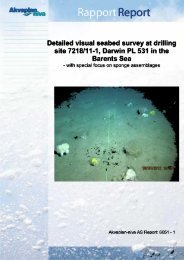A study of the priority substances of the Water Framework Directive ...
A study of the priority substances of the Water Framework Directive ...
A study of the priority substances of the Water Framework Directive ...
You also want an ePaper? Increase the reach of your titles
YUMPU automatically turns print PDFs into web optimized ePapers that Google loves.
� PFAS are very persistent and may harm reproduction.<br />
� General screening is not considered necessary,<br />
but monitoring and screening <strong>of</strong> specific localities<br />
should continue.<br />
Production and use<br />
The use in Norway was estimated to 23 - 26<br />
tons in 2002. Historical data are lacking. PFAS<br />
are mainly used as surfactants, in fire extinguishers<br />
and preservatives in textiles.<br />
Emissions, discharges,<br />
distribution and hot-spots<br />
Emissions in Norway in 2002 are estimated to<br />
13 - 15 tons, but <strong>the</strong>se estimates are very rough.<br />
PFAS may have been used in specific paper productions.<br />
The compound Cera-F may form perfluoroalkyl<br />
compounds. Cera F is used widely in<br />
ski waxes (glider and wax). Possible hotspots<br />
are start areas / ski preparation areas <strong>of</strong> ski<br />
tracks.<br />
Monitoring<br />
PFAS have been screened in <strong>the</strong> program:<br />
"Kartlegging av utvalgte nye organiske<br />
miljøgifter i 2004. Bromerte flammehemmere,<br />
perfluoralkylst<strong>of</strong>fer, irgarol, diuron, BHT og<br />
dic<strong>of</strong>ol" and in a common screening in <strong>the</strong><br />
Nordic environment 2003. There has also been<br />
a Nordic screening related to water resources<br />
affected by landfills or municipal waste water<br />
plants.<br />
Marine sediment<br />
High concentrations are found at<br />
Rubbestadneset in Bømlo.<br />
Marine biota<br />
Concentrations in cod liver (Gadus morhua)<br />
were found to be higher than in an earlier<br />
Nordic screening.<br />
Fresh water<br />
PFAS concentrations in water were low compared<br />
to studies in Germany and USA.<br />
Fresh water sediment<br />
PFAS levels in fresh water sediments were low<br />
compared to levels from <strong>the</strong> Ne<strong>the</strong>rlands.<br />
perfluoroalkyl compounds (PFAS) ::::::::::..<br />
h Perfluoroalkyl compounds (PFAS)<br />
FACTS<br />
PFAS are a class <strong>of</strong> compounds. SFT has shown particular<br />
interest in <strong>the</strong> compounds PFBS, PFHxS, PFOS,<br />
PFDS, PFHpA, PFOA, PFNA and PFOSA. They are highly<br />
persistent and may harm reproduction.<br />
Fresh water biota<br />
The highest levels were found in perch (Perca<br />
fluriatilis) from Hurdalssjøen.<br />
O<strong>the</strong>r<br />
In a Nordic screening, high PFAS concentrations<br />
were found in water affected by municipal<br />
waste water plants.<br />
Need for fur<strong>the</strong>r screening and monitoring<br />
PFAS were screened in 2004. There is no fur<strong>the</strong>r<br />
need for general screening at <strong>the</strong> moment, but<br />
monitoring should continue. Screening should<br />
be performed downstream <strong>of</strong> specific paper<br />
mills as PFAS may have been in former use at<br />
<strong>the</strong>se sites.<br />
Analysis<br />
The methods for analysis <strong>of</strong> PFAS have been<br />
improved through <strong>the</strong> last years. However, this<br />
group <strong>of</strong> compounds possess exceptional chemical<br />
properties (hydrophobic and lipophobic at<br />
<strong>the</strong> same time) which require o<strong>the</strong>r techniques<br />
for sampling, extraction, clean-up and quantification.<br />
Methods<br />
The methods are based on extraction with an<br />
organic solvent or ion-pair extraction, a very<br />
short clean-up and separation and quantification<br />
with LC/MS. During sampling and analysis<br />
adsorption to surfaces must be avoided. During<br />
production <strong>of</strong> fluorinated polymers like Teflon<br />
PFAS has been used. Therefore <strong>the</strong> contact with<br />
Teflon or o<strong>the</strong>r fluorinated polymers can cause<br />
contamination <strong>of</strong> <strong>the</strong> sample during sampling,<br />
storage or analysis.<br />
Synergy with o<strong>the</strong>r analyses<br />
The special character <strong>of</strong> <strong>the</strong> requirements for<br />
PFAS sampling and analysis reduce <strong>the</strong> chance<br />
for synergy with <strong>the</strong> sampling and analysis <strong>of</strong><br />
o<strong>the</strong>r compounds.<br />
A <strong>study</strong> <strong>of</strong> <strong>the</strong> <strong>priority</strong> <strong>substances</strong> <strong>of</strong> <strong>the</strong> <strong>Water</strong> <strong>Framework</strong> <strong>Directive</strong><br />
TA-2140/2005<br />
95:::..

















